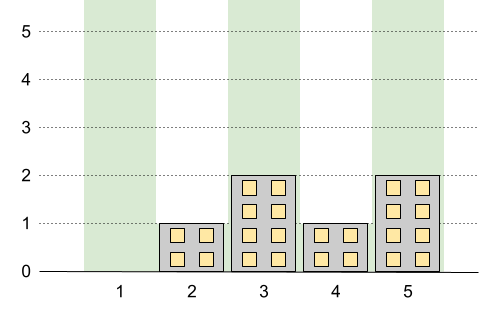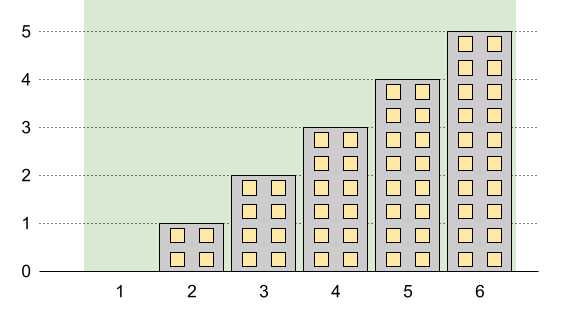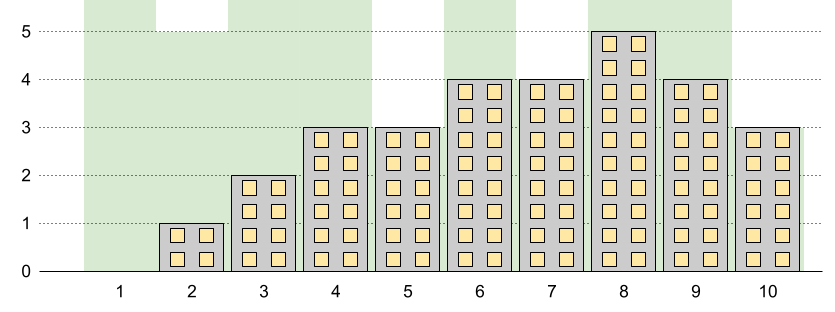1840. Maximum Building Height
Description
You want to build n new buildings in a city. The new buildings will be built in a line and are labeled from 1 to n.
However, there are city restrictions on the heights of the new buildings:
- The height of each building must be a non-negative integer.
- The height of the first building must be
0. - The height difference between any two adjacent buildings cannot exceed
1.
Additionally, there are city restrictions on the maximum height of specific buildings. These restrictions are given as a 2D integer array restrictions where restrictions[i] = [idi, maxHeighti] indicates that building idi must have a height less than or equal to maxHeighti.
It is guaranteed that each building will appear at most once in restrictions, and building 1 will not be in restrictions.
Return the maximum possible height of the tallest building.
Example 1:

Input: n = 5, restrictions = [[2,1],[4,1]] Output: 2 Explanation: The green area in the image indicates the maximum allowed height for each building. We can build the buildings with heights [0,1,2,1,2], and the tallest building has a height of 2.
Example 2:

Input: n = 6, restrictions = [] Output: 5 Explanation: The green area in the image indicates the maximum allowed height for each building. We can build the buildings with heights [0,1,2,3,4,5], and the tallest building has a height of 5.
Example 3:

Input: n = 10, restrictions = [[5,3],[2,5],[7,4],[10,3]] Output: 5 Explanation: The green area in the image indicates the maximum allowed height for each building. We can build the buildings with heights [0,1,2,3,3,4,4,5,4,3], and the tallest building has a height of 5.
Constraints:
2 <= n <= 1090 <= restrictions.length <= min(n - 1, 105)2 <= idi <= nidiis unique.0 <= maxHeighti <= 109
Solutions
Solution: Math
- Time complexity: O(mlogm)
- Space complexity: O(1)
JavaScript
js
/**
* @param {number} n
* @param {number[][]} restrictions
* @return {number}
*/
const maxBuilding = function (n, restrictions) {
restrictions.push([1, 0], [n, n - 1]);
restrictions.sort((a, b) => a[0] - b[0]);
const m = restrictions.length;
let result = 0;
for (let index = 1; index < m; index++) {
const [l, hl] = restrictions[index - 1];
const [r, hr] = restrictions[index];
const interval = r - l;
restrictions[index][1] = Math.min(hr, interval + hl);
}
for (let index = m - 2; index >= 0; index--) {
const [l, hl] = restrictions[index];
const [r, hr] = restrictions[index + 1];
const interval = r - l;
restrictions[index][1] = Math.min(hl, interval + hr);
}
for (let index = 1; index < m; index++) {
const [l, hl] = restrictions[index - 1];
const [r, hr] = restrictions[index];
const interval = r - l - 1;
const highest = Math.max(hl, hr) + Math.ceil((interval - Math.abs(hr - hl)) / 2);
result = Math.max(highest, result);
}
return result;
};